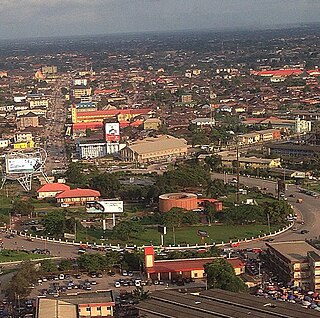
Benin City is the capital and largest city of Edo State, southern Nigeria. In central Kings square, the Benin city National Museum traces the Benin empire and has displays of terracotta sculpture. The Oba's palace is known for bronze plaques that once decorated with the walls, depicting historical events and Life at court. is the fourth-largest city in Nigeria according to the 2006 census, after Lagos, Kano, and Ibadan. It is situated approximately 40 kilometres (25 mi) north of the Benin River and 320 kilometres (200 mi) by road east of Lagos. Benin City is the centre of Nigeria's rubber industry, and oil production is also a significant industry.

The Oba of Benin is the traditional ruler and the custodian of the culture of the Edo people and all Edoid people. The then Kingdom of Benin has continued to be mostly populated by the Edo.
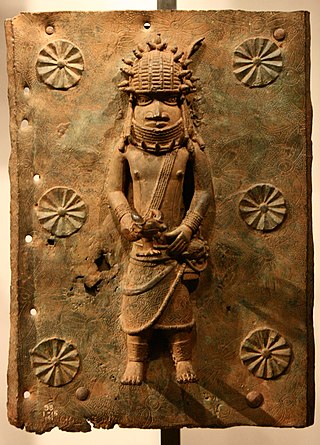
The Benin Bronzes are a group of several thousand metal plaques and sculptures that decorated the royal palace of the Kingdom of Benin, in what is now Edo State, Nigeria. Collectively, the objects form the best examples of Benin art and were created from the thirteenth century by artists of the Edo people. The plaques, which in the Edo language are called Ama, depict scenes or represent themes in the history of the Kingdom. Apart from the plaques, other sculptures in brass or bronze include portrait heads, jewelry, and smaller pieces.

The Esan people (Esan: are an ethnic group of southern Nigeria who speak the Esan language. The Esan are traditionally known to be agriculturalists, trado-medical practitioners, mercenary warriors and hunters. They cultivate palm trees, Irvingia gabonensis, Cherry, bell pepper coconut, betel nut, kola nut, black pear, avocado pear, yams, cocoyam, cassava, maize, rice, beans, groundnut, bananas, oranges, plantains, sugar cane, tomato, potato, okra, pineapple, paw paw, and various vegetables.

The traditional beliefs and practices of African people are highly diverse, including various ethnic religions. Generally, these traditions are oral rather than scriptural and are passed down from one generation to another through folk tales, songs, and festivals, and include beliefs in spirits and higher and lower gods, sometimes including a supreme being, as well as the veneration of the dead, and use of magic and traditional African medicine. Most religions can be described as animistic with various polytheistic and pantheistic aspects. The role of humanity is generally seen as one of harmonizing nature with the supernatural.

Idia was the mother of Esigie, who reigned as Oba (king) of the Edo people from 1504 to 1550. Historians do know that Idia was alive during the Idah war because she played a role that led to a great Benin victory. It has been argued that Idia, therefore, was the true power behind the throne of her son. She played a significant role in the rise and reign of her son, being described as a great warrior who fought relentlessly before and during her son's reign as the Oba (king) of the Edo people. Queen Idia was instrumental in securing the title of Oba for her son Esigie following the death of his father Oba Ozolua. To that end, she raised an army to fight off his brother Arhuaran who was supposed to be the Oba by right and tradition but was subsequently defeated in battle. Esigie’s mother became the 17th Oba of Benin.

Benin art is the art from the Kingdom of Benin or Edo Empire (1440–1897), a pre-colonial African state located in what is now known as the Southern region of Nigeria. Primarily made of cast bronze and carved ivory, Benin art was produced mainly for the court of the Oba of Benin – a divine ruler for whom the craftsmen produced a range of ceremonially significant objects. The full complexity of these works can be appreciated through the awareness and consideration of two complementary cultural perceptions of the art of Benin: the Western appreciation of them primarily as works of art, and their understanding in Benin as historical documents and as mnemonic devices to reconstruct history, or as ritual objects. This original significance is of great importance in Benin.
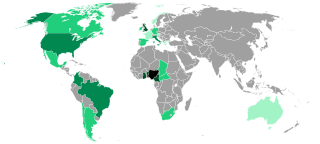
Nigerians or the Nigerian people are citizens of Nigeria or people with ancestry from Nigeria. The name Nigeria was derived from the Niger River running through the country. This name was allegedly coined in the late 19th century by British journalist Flora Shaw, who later married Baron Frederick Lugard, a British colonial administrator. Nigeria is composed of various ethnic groups and cultures and the term Nigerian refers to a citizenship-based civic nationality. Nigerians derive from over 250 ethno-linguistic groups. Though there are multiple ethnic groups in Nigeria, economic factors result in significant mobility of Nigerians of multiple ethnic and religious backgrounds to reside in territories in Nigeria that are outside their ethnic or religious background, resulting in the mixing of the various ethnic and religious groups, especially in Nigeria's cities. The English language is the lingua franca of Nigerians. Nigeria is divided roughly in half between Muslims, who live mostly in the north, and Christians, who live mostly in the south; indigenous religions, such as those native to the Igbo and Yoruba ethnicities, are in the minority.

Uromi is a city located in north-eastern Esan, a sub-ethnic group of the Edo people in Edo state, Nigeria. At various points in Uromi's history, the city and people have been an important part of the Benin Empire.
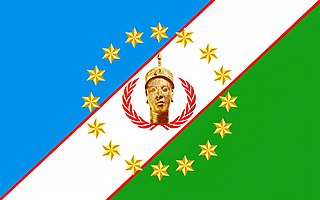
The Yoruba people are a West African ethnic group who mainly inhabit parts of Nigeria, Benin, and Togo. The areas of these countries primarily inhabited by the Yoruba are often collectively referred to as Yorubaland. The Yoruba constitute more than 52 million people in Africa, are over a million outside the continent, and bear further representation among members of the African diaspora. The vast majority of the Yoruba population is today within the country of Nigeria, where they make up 21% of the country's population according to CIA estimations, making them one of the largest ethnic groups in Africa. Most Yoruba people speak the Yoruba language, which is the Niger-Congo language with the largest number of native or L1 speakers.
Igueben is a local government area of Edo State, Nigeria. Its headquarters are located in the town of Igueben, which has an area of 380 km2 (150 sq mi) and a population of 69,639 according to the 2006 census. The postal code is 310.
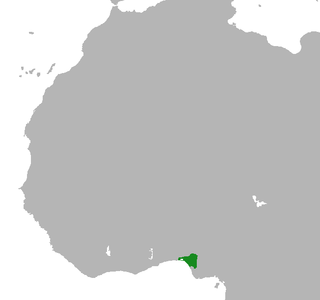
The Kingdom of Benin, also known as the Edo Kingdom or the Benin Empire, was a kingdom within what is now southern Nigeria. It has no historical relation to the modern republic of Benin, which was known as Dahomey from the 17th century until 1975. The Kingdom of Benin's capital was Edo, now known as Benin City in Edo State, Nigeria. The Benin Kingdom was "one of the oldest and most developed states in the coastal hinterland of West Africa". It grew out of the previous Edo Kingdom of Igodomigodo around the 11th century AD, and lasted until it was annexed by the British Empire in 1897.
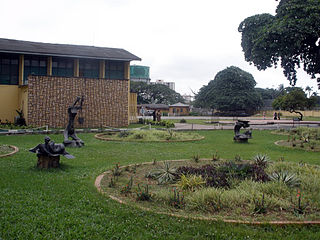
The Nigerian National Museum is a national museum of Nigeria, located in the city of Lagos. The museum has a notable collection of Nigerian art, including pieces of statuary, carvings also archaeological and ethnographic exhibits. Of note is a terracotta human head known as the Jemaa Head, part of the Nok culture. The piece is named after Jema'a, the village where it was discovered. The museum is located at Onikan, Lagos Island, Lagos State. The museum is administered by the National Commission for Museums and Monuments.
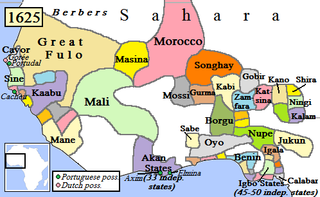
Nigerian traditional rulers often derive their titles from the rulers of independent states or communities that existed before the formation of modern Nigeria. Although they do not have formal political power, in many cases they continue to command respect from their people and have considerable influence in their community.

The Benin ivory mask is a miniature sculptural portrait in ivory of Idia, the first Iyoba of the 16th century Benin Empire, taking the form of a traditional African mask. The masks were looted by the British from the palace of the Oba of Benin in the Benin Expedition of 1897.

Esanland, is a cultural region located in Edo State, Nigeria. It is composed of five Local Government Areas in Edo State. Esanland lies west of the banks of the Niger River. It is bordered by Kogi State, Delta State, Edo South Senatorial District, and Edo North Senatorial District. Esanland covers about 2,800 square kilometers and is home to over half a million people. The Esan people and culture of Esanland are generally homogenous.
Unuamen also spelt Unuame is an ancient village community by Ovia river in Ovia North-East Local Government Area of Edo State, Nigeria. Unuame is about 15 kilometres (9 mi) from Benin City and 20 kilometres (12 mi) from Benin Airport. Unuame is one of the ancestral homes of Oba Esigie's maternal grandfather and home town to some group of Binis. The people of Unuame have remained loyal to the monarch since the establishment of the ancient Kingdom of Benin. Being a part of the Kingdom of Benin, Unuame is at the heart of the tropical rainforest in the southern part of Nigeria, way to the west of the delta of the Niger River and inland from the coast.
Abudu is a town located in Edo State, Nigeria. It was founded in the 18th century and has since become a trading and cultural center in the region. Abudu is situated in the southern part of Edo State and serves as the headquarters of the Orhionmwon Local Government Area.
The Ovia River or Osse River is a watercourse in Edo State, Nigeria, spanning approximately 120 kilometers through diverse terrain.
The Oba Market also referred to as Eki-Oba is an open-air market situated at Ring Road in the center of Benin City, Edo State, Nigeria. Its roots date back to the 15th century, making it one of the most historically significant markets in the region.














